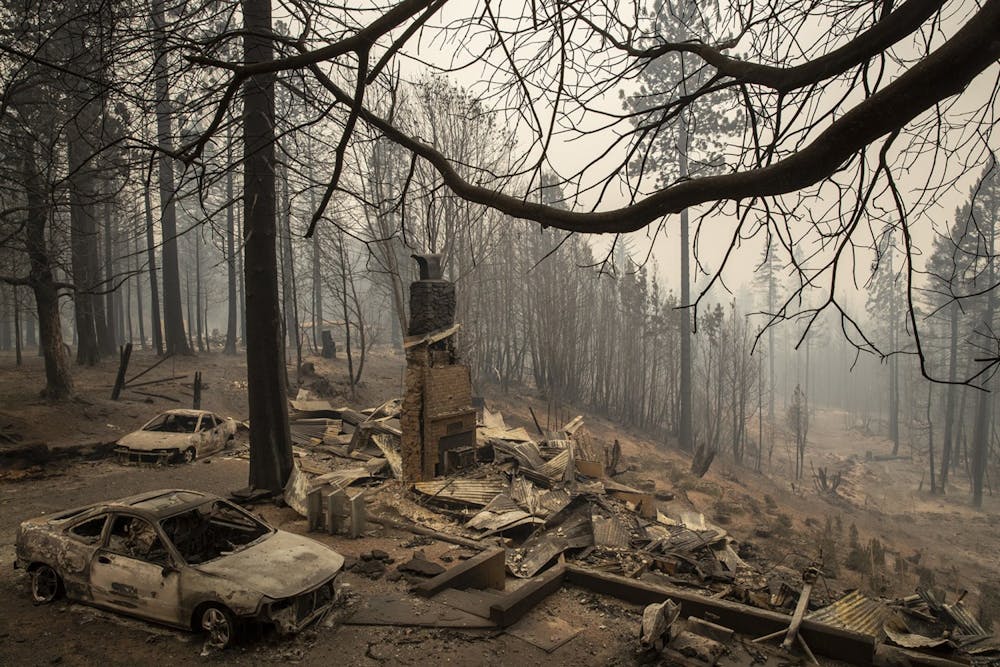The recent wildfires in California are tragic, and the sheer loss stemming from them is catastrophic. This is one of California’s worst wildfire seasons ever, and it’s not even over yet. This year alone, 3.1 million acres of land in California have burned. For comparison, about 300,000 acres burn in an average California wildfire season.
This is a new normal we are hurtling towards — orange skies and daily smog covering our cities, picnics in the park in the middle of wildfires, intense heat waves and droughts. Soon, we might not be able to go outside without a mask on, not because of the pandemic, but because our air will be filled with so many pollutants.
The fact is there is one main culprit at play: climate change. Climate change increases the severity of not only wildfires, but also amplifies all weather patterns from hurricanes and floods to heat waves and droughts. This can be seen through wildfires in California, the Australian wildfires at the beginning of 2020 and in the hurricanes devastating Puerto Rico in recent years.
So what caused the California wildfires to get so out of hand, and how is this connected to climate change? Obviously, climate change didn’t physically spark the flames that started the fires, but the various factors at play caused by climate change added to the severity of the fires. Recent triple digit temperatures and prolonged droughts in the area are directly related to climate change.
The frequency of these weather events has also increased in recent years. More frequent droughts and heat waves lead to more fires, and those fires burn hotter and faster.
Climate change often feels like a distant fear, something that doesn’t affect the average person on a daily basis, but these wildfires are a tangible byproduct of our changing climate. People are losing their homes. People are losing their lives.
This affects the Bloomington community too. What happens this winter when there is a cold wave, and then a severe snowstorm hits? Power lines go out and the roads are unmanageable. Families are stuck inside for days. Hail breaks windows and damages roofs.
This is only the beginning.
The United States already spent $350 billion from 2008 to 2018 on damage related to climate change. By the year 2090, this number could grow to $224 billion a year, according to a Nature Climate Change report. This money should instead be going to preventing climate change in the first place.
Climate change affects the lives of every individual on this planet. By choosing to ignore the damage we are doing to our planet, we are losing so much.
That's not all. This is only the damage caused by extreme weather patterns. Climate change can be connected to deforestation, the collapse of entire ecosystems, food instability, water shortages and more.
Crop failures will also directly affect our economy in Indiana, which heavily relies on corn crops. A mere four degree Celsius increase in our global climate could cause corn production to decrease by 46.5% in the U.S. alone. This would be no small hit, as corn production in Indiana is valued at $4.07 billion annually. An economic loss of this magnitude could be devastating.
Climate change needs to be taken seriously and addressed in our government. Our country's inaction is costing lives today, and it could cost us our planet in the future. Sitting idly by and ignoring the signs of climate change in our everyday lives needs to stop if we hope to halt or even reverse the damage done.
Vote with this in mind and pay attention to who is running for office at both local and national levels. Empower and give a voice to those who have plans of actions and want to take decisive, preventative measures to save this planet. We don't have much time left before the damage done is irreversible.
Aidan Kramer (she/her) is a freshman studying microbiology and environmental science. After graduating, she plans to attend medical school and pursue a career in pathology.






